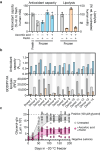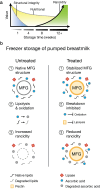Food-Derived Compounds Extend the Shelf Life of Frozen Human Milk
- PMID: 40565627
- PMCID: PMC12191995
- DOI: 10.3390/foods14122018
Food-Derived Compounds Extend the Shelf Life of Frozen Human Milk
Abstract
Breastmilk is known to provide optimal nutrition for infant growth and development. A cross-sectional analysis of nationally representative US data from 2016 to 2021 revealed that >90% of lactating mothers reported using breast pumps to express milk. We conducted a survey of n = 1049 lactating or recently lactating individuals from a US nationally representative population to explore breastmilk storage practices among this group. The data revealed that 83% of respondents store breastmilk in their homes, with 68% using freezers to do so for >1 month. The lowest available temperature in most household freezers is -20 °C, a temperature that is inadequate to maintain human milk's emulsified structure, leading to separation, degradation of fats, loss of key vitamins, and changes in palatability. We developed a first-of-its-kind high-throughput screening platform to identify food-derived compounds and combinations of compounds that, when added to human breastmilk, preserve fat content, retain antioxidant capacity, and reduce production of rancid-associated free fatty acids during extended freezer storage. Our screening identified pectin (0.5% w/v) and ascorbic acid (100 μg/mL) as optimal preservation agents. Compared to untreated controls, this formulation reduced glycerol production by approximately 60% and maintained antioxidant capacity after 6 months of storage at -20 °C. Lysozyme and protease activity were maintained at >75% of the levels in fresh breastmilk. This formulation represents a lead for the development of safe and affordable frozen breastmilk shelf-life extenders for at-home use to increase the longevity of stored breastmilk.
Keywords: breast pump; breastfeeding; freezer storage; high-throughput screening; household storage; human milk; lipolysis; milk preservation; milk storage.
Conflict of interest statement
The authors disclose affiliation with and equity in PumpKin Baby Inc., a Princeton University spinout and for-profit public benefit corporation formed over the course of this work. PumpKin Baby Inc. is working to develop and commercialize the technology presented in this report, as the organization’s stated purpose is “to provide access to scientific research and products that aim to improve access to breastmilk, breastfeeding, and maternal and infant health.” Several patents related to the technology described in this manuscript are pending and assigned to Princeton University.
Figures



Update of
-
Food-Derived Compounds Extend the Shelf-Life of Frozen Human Milk.bioRxiv [Preprint]. 2025 Jan 12:2024.12.11.627965. doi: 10.1101/2024.12.11.627965. bioRxiv. 2025. Update in: Foods. 2025 Jun 07;14(12):2018. doi: 10.3390/foods14122018. PMID: 39713284 Free PMC article. Updated. Preprint.
Similar articles
-
Food-Derived Compounds Extend the Shelf-Life of Frozen Human Milk.bioRxiv [Preprint]. 2025 Jan 12:2024.12.11.627965. doi: 10.1101/2024.12.11.627965. bioRxiv. 2025. Update in: Foods. 2025 Jun 07;14(12):2018. doi: 10.3390/foods14122018. PMID: 39713284 Free PMC article. Updated. Preprint.
-
Breastfeeding promotion for infants in neonatal units: a systematic review and economic analysis.Health Technol Assess. 2009 Aug;13(40):1-146, iii-iv. doi: 10.3310/hta13400. Health Technol Assess. 2009. PMID: 19728934
-
Medications for increasing milk supply in mothers expressing breastmilk for their preterm hospitalised infants.Cochrane Database Syst Rev. 2012 Mar 14;2012(3):CD005544. doi: 10.1002/14651858.CD005544.pub2. Cochrane Database Syst Rev. 2012. PMID: 22419310 Free PMC article.
-
Extending the performance shelf life of direct-salted block Gouda.J Dairy Sci. 2025 Jul;108(7):6711-6729. doi: 10.3168/jds.2025-26527. Epub 2025 Apr 28. J Dairy Sci. 2025. PMID: 40306416
-
Nutritional interventions for survivors of childhood cancer.Cochrane Database Syst Rev. 2016 Aug 22;2016(8):CD009678. doi: 10.1002/14651858.CD009678.pub2. Cochrane Database Syst Rev. 2016. PMID: 27545902 Free PMC article.
References
-
- CDC 2022 Breastfeeding Report Card. [(accessed on 12 April 2024)]; Available online: https://www.cdc.gov/breastfeeding/data/reportcard.htm.
-
- CDC Facts About Nationwide Breastfeeding Goals. [(accessed on 6 September 2024)]; Available online: https://www.cdc.gov/breastfeeding/data/facts.html.
-
- Gao G., Livingston G. Working While Pregnant Is Much More Common than It Used to Be. Pew Research Center; Basel, Switzerland: 2015.
-
- Light P. Why 43% of Women with Children Leave Their Jobs, and How to Get Them Back. The Atlantic; Washington, DC, USA: 2013.
Grants and funding
LinkOut - more resources
Full Text Sources

